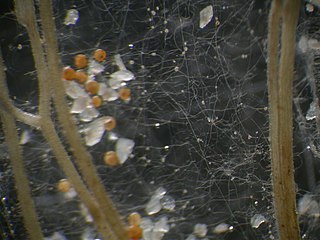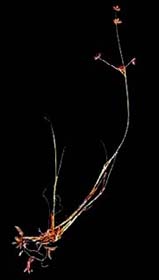
An arbuscular mycorrhiza (AM) is a type of mycorrhiza in which the symbiont fungus penetrates the cortical cells of the roots of a vascular plant forming arbuscules. Arbuscular mycorrhiza is a type of endomycorrhiza along with ericoid mycorrhiza and orchid mycorrhiza .They are characterized by the formation of unique tree-like structures, the arbuscules. In addition, globular storage structures called vesicles are often encountered.

The Hypocreales are an order of fungi within the class Sordariomycetes. In 2008, it was estimated that it contained some 237 genera, and 2647 species in seven families. Since then, a considerable number of further taxa have been identified, including an additional family, the Stachybotryaceae. Wijayawardene et al. in 2020 added more families and genera to the order. According to the Catalog of Life, As of April 2021 the Hypocreales contains 6 families, 137 genera, and 1411 species. Hyde et al. (2020a) listed 14 families under Hypocreales, while, Wijayawardene et al. (2022) accepted 15 families in the order, where Cylindriaceae was additionally added. Earlier, Hyde et al. (2020a) had placed Cylindriaceae in class Xylariomycetidae. Samarakoon et al. (2022) agreed. Hence, Cylindriaceae should have been excluded from Hypocreales and placed in Xylariomycetidae. Xiao et al. (2022) recently introduced a new family Polycephalomycetaceae to Hypocreales.

Glomeromycota are one of eight currently recognized divisions within the kingdom Fungi, with approximately 230 described species. Members of the Glomeromycota form arbuscular mycorrhizas (AMs) with the thalli of bryophytes and the roots of vascular land plants. Not all species have been shown to form AMs, and one, Geosiphon pyriformis, is known not to do so. Instead, it forms an endocytobiotic association with Nostoc cyanobacteria. The majority of evidence shows that the Glomeromycota are dependent on land plants for carbon and energy, but there is recent circumstantial evidence that some species may be able to lead an independent existence. The arbuscular mycorrhizal species are terrestrial and widely distributed in soils worldwide where they form symbioses with the roots of the majority of plant species (>80%). They can also be found in wetlands, including salt-marshes, and associated with epiphytic plants.

Kickxellomycotina is a fungus grouping. In the subkingdom of Zoopagomyceta Benny, 2007.

The Mortierellaceae are a family of fungi in the order Mortierellales. The family contains six genera and 93 species.

Entorrhizomycetes is the sole class in the phylum Entorrhizomycota, within the Fungi subkingdom Dikarya along with Basidiomycota and Ascomycota. It contains three genera and is a small group of teliosporic root parasites that form galls on plants in the Juncaceae (rush) and Cyperaceae (sedge) families. Prior to 2015 this phylum was placed under the subdivision Ustilaginomycotina. A 2015 study did a "comprehensive five-gene analyses" of Entorrhiza and concluded that the former class Entorrhizomycetes is possibly either a close sister group to the rest of Dikarya or Basidiomycota.
Echinochlamydosporium is a fungal genus in the Mortierellaceae family of the Zygomycota. The genus is monotypic, containing the single species Echinochlamydosporium variabile, found in China. The fungus grows on juvenile individuals of the soybean cyst nematode.

An ectomycorrhiza is a form of symbiotic relationship that occurs between a fungal symbiont, or mycobiont, and the roots of various plant species. The mycobiont is often from the phyla Basidiomycota and Ascomycota, and more rarely from the Zygomycota. Ectomycorrhizas form on the roots of around 2% of plant species, usually woody plants, including species from the birch, dipterocarp, myrtle, beech, willow, pine and rose families. Research on ectomycorrhizas is increasingly important in areas such as ecosystem management and restoration, forestry and agriculture.
Myrmecridium is a genus of fungi in the class Sordariomycetes. It was circumscribed in 2007 and is distinguished from similar fungi by having entirely hyaline (translucent) vegetative hyphae and widely scattered, pimple-shaped denticles on the long hyaline rachis. The generic name derives from a combination of the Ancient Greek word "myrmekia", meaning "wart", and the suffix "-ridium" from "Chloridium".

Opisthosporidia is a superphylum of intracellular parasites with amoeboid vegetative stage, defined as a common group of eukaryotic groups Microsporidia, Cryptomycota and Aphelidea. They have been considered to represent a monophyletic lineage with shared ecological and structural features, being a sister clade of the Fungi. Together with the Fungi they represent a sister clade of the Cristidiscoidea, together forming the Holomycota.
Anaerolineaceae is a family of bacteria from the order of Anaerolineales. Anaerolineaceae bacteria occur in marine sediments. There are a total of twelve genera in this family, most of which only encompass one species. All known members of the family are Gram-negative and non-motile. They also do not form bacterial spores and are either mesophilic or thermophilic obligate anaerobes. It is also known that all species in this family are chemoheterotrophs.

Mucoromycota is a division within the kingdom fungi. It includes a diverse group of various molds, including the common bread molds Mucor and Rhizopus. It is a sister phylum to Dikarya.

Amastigomycota or Eufungi is a clade of fungi. It includes all fungi without flagella or centrioles, and with unstacked Golgi apparatus cisternae. Members of this clade are Dikarya and the traditional paraphyletic assemblage "Zygomycota", now divided into several monophyletic phyla.
Cystofilobasidium is a genus of fungi in the family Cystofilobasidiaceae. Species occur as yeasts, but produce filamentous sexual states that form dikaryote teliospores, from which the unicellular basidia are formed. The hyphae usually have dolipore septa without a parenthesome, and their cell walls contain xylose. The genus currently contains nine species worldwide.
Fuscosporellales is an order of fungi within the phylum of Ascomycota and in the class Sordariomycetes and subdivision of Pezizomycotina.
Pisorisporiales is an order of fungi within the phylum of Ascomycota and in the class Sordariomycetes and subdivision of Pezizomycotina and also its own subclass Pisorisporiomycetidae.
Pleurotheciaceae is a family of ascomycetous fungi within the monotypic order of Pleurotheciales in the subclass Savoryellomycetidae and within the class Sordariomycetes.
Pararamichloridium is a genus of fungi in the monotypic family Pararamichloridiaceae and within the monotypic order of Pararamichloridiales and also in the subclass Hypocreomycetidae. They are saprobic on wood in terrestrial and freshwater habitats.

Juncigenaceae is a family of ascomycetous marine based fungi within the order of Torpedosporales in the subclass Hypocreomycetidae and within the class Sordariomycetes. They are saprobic to intertidal wood, within mangrove forests and other herbaceous wood and roots, bark, leaves in various marine habitats.
Torpedosporaceae is a monotypic family of ascomycetous marine based fungi within the order of Torpedosporales in the subclass Hypocreomycetidae and within the class Sordariomycetes. They are saprobic on intertidal mangrove wood and roots, bark leaves, and sand in various marine habitats.










